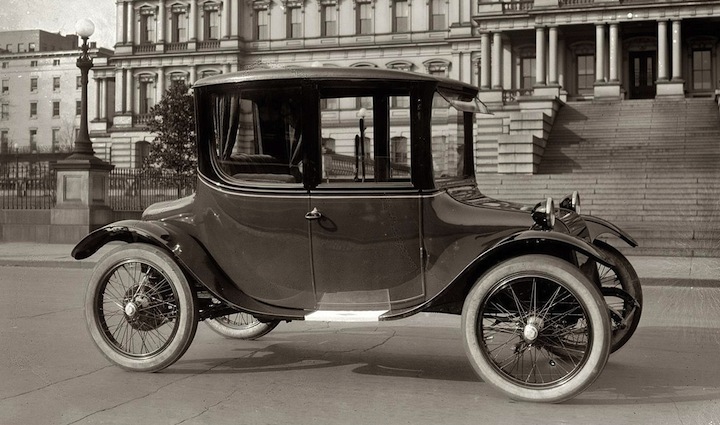The electric car was more than niche vehicle early in 20th Century

By Jim Meachen
Editor, Abandoned Cars and Trucks
(April 12, 2014) It's surprising and, frankly, somewhat amazing how little progress we have made in electric cars over the past century. Not in the cars themselves, which have obviously evolved many times over, but in the electrical system.
Range is still a big bugaboo and has not increased significantly from 100 years ago when the Detroit Electric Car was being sold in relatively large numbers.
We ran across a well-preserved edition of the 1913 Detroit Electric Car in the Virginia Museum of Transportation in Roanoke, Va. The display car was purchased in 1913 by Frederick Kramer Darragh for his mother, Mrs. Louisa K. Darragh of Little Rock, Ark., for $3,000. The three grand apparently purchased several options on the "Clear Vision Brougham Model 42" including "plush upholstery, interior lighting, window curtains and flower vases."
The car operated on 14 six-volt batteries with a top speed of 25 mph and a range of 75 miles, according to information at the museum.
Detroit Electric (1907–1939) was an automobile brand produced by the Anderson Electric Car Company in Detroit, Mich.
Production of the electric automobile, powered by a rechargeable lead acid battery, began in 1907. For an additional $600, an Edison nickel-iron battery was available from 1911 to 1916. The cars were advertised as reliably getting 80 miles between battery recharging, although in one test a Detroit Electric ran 211.3 miles on a single charge. Top speed was only about 20 miles per hour, but this was considered adequate for driving within city or town limits at the time.
The Detroit Electric was mainly sold to women drivers and physicians who desired the dependable and immediate start without the physically demanding hand cranking of the engine that was required with early internal combustion engine autos. A statement of the car's refinement was subtly made to the public through its design which included the first use of curved window glass in a production automobile, an expensive and complex feature to produce.
The company production was at its peak in the 1910s selling around 1000 to 2000 cars a year. Towards the end of the decade the Electric was helped by the high price of gasoline during World War I. In 1920 the name of the Anderson company was changed to "The Detroit Electric Car Company" as the car maker separated from the body business.
As improved internal combustion engine automobiles became more common and inexpensive, sales of the Electric dropped in the 1920s but the company stayed in business producing Detroit Electrics until after the stock market crash of 1929. The company filed for bankruptcy, but was acquired and kept in business on a more limited scale for some years building cars in response to special orders. The last Detroit Electric was shipped on February 23, 1939.
Top photo: 1921 Detroit Electric
Source: Wikipedia
